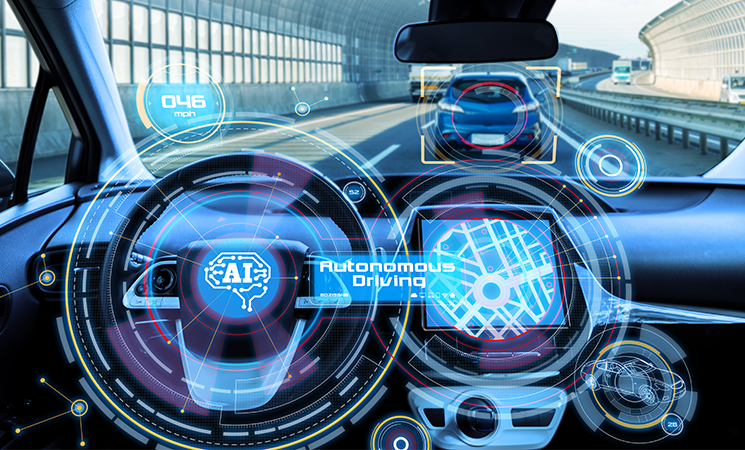Current Trends in Autonomous Vehicle Adoption
Autonomous vehicles with Advanced Driver Assistance Systems (ADAS) can reduce accidents, expand delivery options, and improve the safety of public transportation. While some of the technology for self-driving systems is in use today, moving to a completely autonomous driving model will be a gradual process combining software and hardware innovation with public acceptance.
The Road to Autonomous Driving
The latest SAE International standards describe six levels of autonomous (self-driving) capability, ranging from unaided to completely autonomous vehicles.

Image source: National Highway Traffic Safety Administration
Levels 0-2 provide support features that require human oversight. The driver is completely engaged and must control the vehicle.
- Level 0 includes support features that provide system warnings and momentary help like automatic emergency braking and blind spot warnings.
- Level 1 provides steering or brake acceleration support. Features include adaptive cruise control and lane centering.
- Level 2 provides steering and brake acceleration support.
In Levels 3-5, automated driving features are engaged, even if the driver is present. In Levels 4 and 5, the driver is not required to take over driving.
- Level 3 has features like Traffic Jam Assist where the system brakes and accelerates automatically to manage vehicle speed and maintain safe distance from other vehicles. The driver must drive when notified by the system.
- In Level 4, the vehicle is fully automated and capable of navigating, accelerating, braking, and monitoring the vehicle and roadway in limited conditions (weather, roadway, etc.) without driver intervention. Level 4 vehicles will not operate unless all required conditions are met.
- Level 5 has the automation capability of Level 4 and can operate under all conditions.
While these levels are helpful for describing an autonomous driving experience, cars in the real world won’t jump seamlessly from one level to the next. Instead, different capabilities will advance to mass use at different rates. Here are our expectations for adoption over the next decade.
Early Adoption Through 2023
Much of the technology already exists for autonomous vehicles. Some current car models have Level 2 technology, and in some cases, Level 3. In line with McKinsey & Company observations, many OEMs are focusing on deploying Level 2 and Level 2+ partial automation driving systems in mass-market vehicles and Level 3 conditional automation in a few premium models. Automotive manufacturers from Acura to Volvo are offering ADAS features in their 2021 lineup, including adaptive cruise control, hands-on lane centering, and even hands-free lane centering in several models. Audi briefly introduced Traffic Jam Pilot for its A8 model—a Level 3 system that can automatically steer, accelerate and brake on highways without driver control (the system was withdrawn globally in late 2020 due to regulatory complications).
McKinsey also identifies this period as the start of Level 4 autonomy as the auto industry starts tests and integrates technology. For example, Waymo, a subsidiary of Alphabet, Inc., introduced self-driving taxis in 2020. It allows local customers to call a fully autonomous car using its Waymo One app. While the pilot has been successful, these Level 4 vehicles operate only at low speeds and in suburban areas.
Over the next year, Waymo plans to introduce its robo-taxi service to other selected locations in California, Nevada, and Florida. And globally, China is predicted to lead the charge to Level 4 robo-taxis for public use in predefined geographies. China also plans to deploy autonomous shuttles commercially in controlled environments.
Start of Mass Commercialization by 2027
As the industry heads towards Level 4 adoption, autonomous vehicles will need more computing power and short latency to work safely in traffic and at higher speeds. Self-driving vehicles use a combination of technologies: radio detection and ranging (radar), light detection and ranging (LiDAR), cameras, ultrasound and radio antennas for navigation and communication.

Source: Landmark Dividend
Wide-scale implementation of 5G cellular networks will let autonomous vehicles connect to high-speed networks. Vehicles will be able to communicate with other Internet of Things (IoT) devices to exchange information about routes, position and road conditions.
True Autonomy by 2032
By 2032, technology advances in sensors and software will reach Level 5 capability to guide autonomous vehicles through bad weather and in rural areas where the roads aren’t as well defined as metropolitan areas.
By this point, software becomes a major driver in transforming car capabilities, completing the evolution to the concept of the “software defined car.” In parallel, LiDAR will become a key sensing technology for detecting objects and determining distances. To progress to Levels 4 and 5, vehicles will need MEMs-based LiDAR, which means you need something to control the MEM devices. Microchip provides high-voltage devices that customers are using for these systems today. Microchip’s Ethernet portfolio, consisting of PHYs and switches, offers the high-speed throughput needed to connect LiDAR sensors in an autonomous driving environment. We also offer solutions for control, diagnostics, power management, timing and security, for a complete system design for future generations of surround-view camera systems in ADAS.
According to Startup-Insights, the leading trend in the automotive industry is autonomous vehicles. The move to 100% adoption will occur in many steps and require an end-to-end approach that integrates independent software elements into a comprehensive networked platform with fewer proprietary components and decreased complexity.
